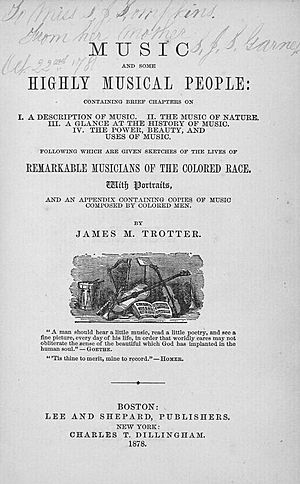Music and Some Highly Musical People facts for kids

Music and Some Highly Musical People is a book about the history of African-American music. James Monroe Trotter wrote it, and it was first published in 1878. This book was one of the first to look at American music from many different styles in one place.
The book shares the life stories of more than forty African-American musicians and music groups. Some famous people included are Elizabeth Taylor Greenfield, Henry F. Williams, Thomas J. Bowers, Thomas Greene Bethune, Rachel M. Washington, Sarah Sedgewick Bowers, the Fisk Jubilee Singers, and the Georgia Minstrels.
Contents
Understanding the Book's Time
Trotter's book shows a lot about the society it was written in. He had to be careful with his words. For example, when he wrote about Elizabeth Greenfield, he couldn't fully talk about the unfair things said about her. This was because he didn't want to upset white readers. They might not have understood how harmful stereotypes about Black musicians were.
For instance, Trotter quoted reviews that praised Greenfield's talent as "untaught" or "innate." This made it seem like her talent was natural, not from hard work or training. This idea often made Black musicians seem less skilled than white, educated musicians.
Showing Strength Against Stereotypes
Historian Lawrence Schenbeck explains that Trotter's work shows something called the "Culture of Dissemblance." This means rejecting a stereotype by acting in the exact opposite way. For example, Trotter described Elizabeth Greenfield as having perfect, childlike morals. This was a way to fight against negative ideas about Black people.
However, Trotter's book also showed some of the wrong ideas common at that time. For example, he sometimes praised lighter skin. He also repeated ideas from phrenologists. These were people who wrongly believed that a person's character was linked to the shape of their head. Today, we know these ideas are not true and are harmful.
Classical Music and Uplift
Trotter's writing about classical music was influenced by a movement. This movement wanted to make classical music as respected as a religious service. A key leader in this idea was a white journalist named John Sullivan Dwight.
Because classical music was so highly respected, Trotter used it to show the talent of Black musicians. He wrote about classical soloists like Thomas Wiggins and Sisieretta Jones. Their performances became examples of how Black culture could be uplifted through music. However, some white people saw Black musicians performing classical music as strange or even offensive. It was not always seen as a positive step.
Exploring Other Music Styles
Trotter also wrote about other types of music, known as vernacular music. He greatly admired gospel musicians, especially the Fisk Jubilee Singers.
On the other hand, Trotter agreed that minstrelsy was usually "disgusting" and "buffoonery." Minstrel shows often used racist stereotypes and caricatures. Even so, his book was one of the first to look at Black minstrelsy in a new way. He suggested that even from this racist style, Black performers found ways to express music. It also gave them jobs and made audiences happy. The book talks about the work of groups like the Georgia Minstrels as an example.
The Book's Impact
Eileen Southern, a music expert, said that Trotter's book was the first time anyone, Black or white, tried to look at American music across many different styles.
This book was part of a larger group of writings from that time and later. In 1883, a white composer named Frederic Louis Ritter published a similar book called Music in America. He recognized Trotter's research on Black contributions to both popular and classical music.
Trotter's book directly influenced many later works about African-American music. This was especially true for books written by Black authors. These include Penman Lovinggood Sr.'s Famous Modern Negro Musicians (1921). Later, in 1936, two important books by Black authors came out: Alain LeRoy Locke's The Negro and His Music and Maud Cuney Hare's Negro Musicians and Their Music.
More recently, Eileen Southern published The Music of Black Americans: A History in 1971. She also started editing a journal called The Black Perspective in Music in 1973. Another major journal, Black Music Research Journal, was started in 1980.
Musicians Featured in the Book
- Joseph G. Anderson
- William Appo
- Dennis Auguste
- Basile Bares
- Thomas Greene Bethune
- William Brady
- Nellie E. Brown
- Sarah Sedgewick Bowers
- Thomas J. Bowers
- James Caseras
- Colored American Opera Company
- Walter F. Craig
- Edmond Dédé
- James Gloucester Demarest
- Marice J. B. Doublet
- John T. Douglass
- Dupre Family
- Fisk Jubilee Singers
- Georgia Minstrels
- Elizabeth Taylor Greenfield
- Justin Holland
- Hyers Sisters
- Samuel W. Jamison
- Frank Johnson
- Lambert Family
- Frederick Elliot Lewis
- Luca Family Singers
- Samuel Lucas
- E. V. Macarty
- Thomas Martin
- Charls Martinez
- John Moore
- Peter P. O'Fake
- Samuel Snaer
- William H. Starr
- G. H. W. Stewart
- Rachel M. Washington
- Joseph White
- A. P. Williams
- Henry F. Williams


